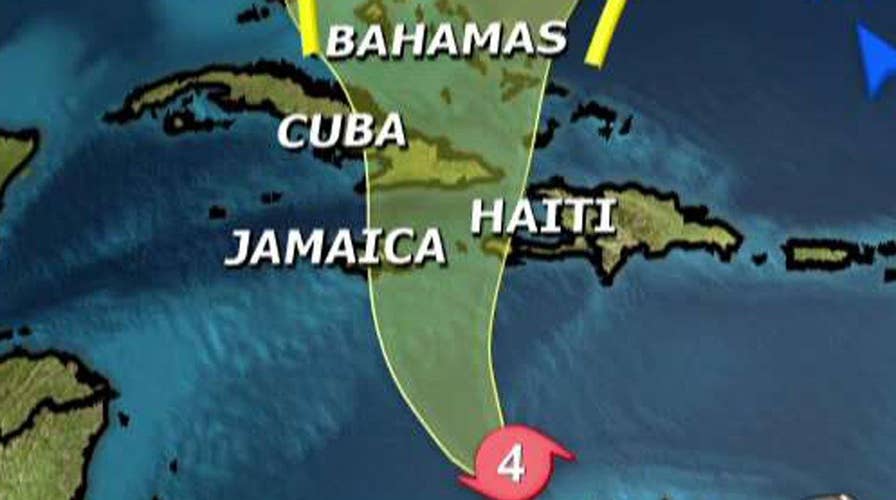Hurricane Matthew poses serious risk for Haiti and Jamaica
Storm could potentially impact the East Coast of the U.S.
Hundreds of non-essential personnel were being evacuated from the U.S. Naval Station at Guantanamo Bay, Cuba early Sunday ahead of a possible direct hit by Hurricane Matthew.
The latest forecasts called for Matthew, a Category 4 storm, to reach Cuba on Tuesday. There are about 5,500 people living on the Guantanamo Bay base, including 61 terrorism suspects held at the detention center.
A mandatory evacuation of non-essential personnel, including about 700 family members of military personnel, was underway at the base and everyone remaining behind was being told to take shelter, spokeswoman Julie Ann Ripley told the Associated Press. The families were to be airlifted to Florida.
Matthew is one of the most powerful Atlantic hurricanes in recent history and briefly reached the top classification, Category 5, before weakening slightly to a high-end Category 4 storm with winds of 150 miles per hour. It is the strongest hurricane here since Felix in 2007.
While previous forecasts had Matthew passing near or over the eastern tip of Jamaica, the latest projection has it shifting eastward and possibly striking the southwestern tip of Haiti on Monday.
The forecast track would also carry Matthew into the Bahamas, with an outside chance of a brush with Florida, though that would be several days away.
"It's too early to rule out what impacts, if any, would occur in the United States and Florida," said Dennis Feltgen, a spokesman at the Hurricane Center.
In Haiti, civil protection officials broadcast warnings of a coming storm surge and big waves, saying the country would be "highly threatened" from the approaching system, which is expected to start affecting Haiti and Jamaica Sunday night. They urged families to prepare emergency food and water kits.
Emergency management authorities banned boating, particularly along the impoverished country's southern coastline.
In Jamaica, where there is also a hurricane warning, flooding temporarily closed the road linking the capital to its airport. Carl Ferguson, head of the marine police, said people were starting to heed calls to relocate from small islands and areas near rural waterways.
Residents of the capital, Kingston, crowded supermarkets to buy bottled water, canned food and batteries. In the coastal town of Port Royal, officials were urging residents to seek refuge in government shelters once they open up on Sunday.
Many Jamaicans also began stocking up for the emergency.
At the Azan Super Centre, a supermarket in Kingston, shoppers were scooping up flashlights and gas lamps and other key supplies along with food. The kerosene was already sold out.
"It has been chaos from the morning," owner Melain Azan said.
Shopper Nardia Powell said she was stocking up because she learned a hard lesson when she was unprepared for Hurricane Ivan in 2004, as were many others. "So, I just want to be on the safe side, right?" she said.
Jamaicans are accustomed to intense storms, but Hurricane Matthew looked particularly threatening. At its peak, it was more powerful than Hurricane Gilbert, which made landfall on the island in September 1988 and was the most destructive storm in the country's modern history.
As of 2 a.m. EDT, the storm was centered about 350 miles south-southwest of Port-au-Prince, Haiti. It was traveling north-northwest at 6 mph.
Earlier, Matthew skimmed past the northern tip of South America where there were reports of at least two deaths.
But authorities in the area overall breathed a sigh of relief as damage appeared minimal despite flooding in towns along the La Guajira peninsula of Colombia. Some officials were even grateful for the rain after a multi-year drought in the poverty-stricken area.
"Families that evacuated are returning to their homes," said La Guajira Gov. Jorge Velez. "The dikes and wells filled up, the earth is moist, and this benefits agriculture in an area where it hasn't rained for five years, benefiting the community."
The Associated Press contributed to this report.





















